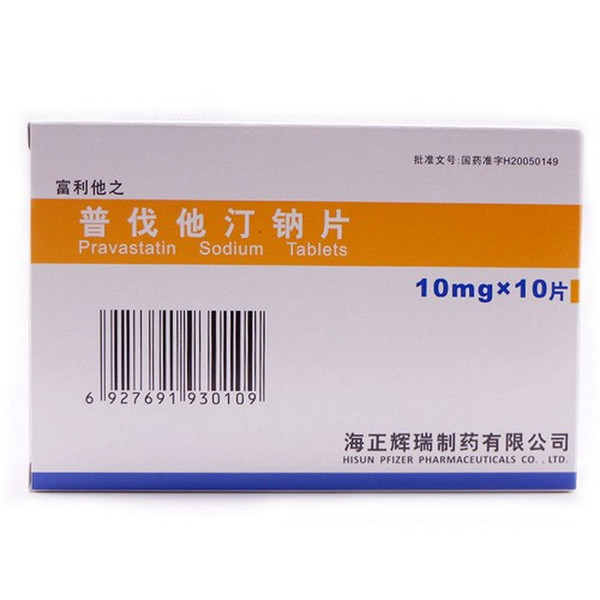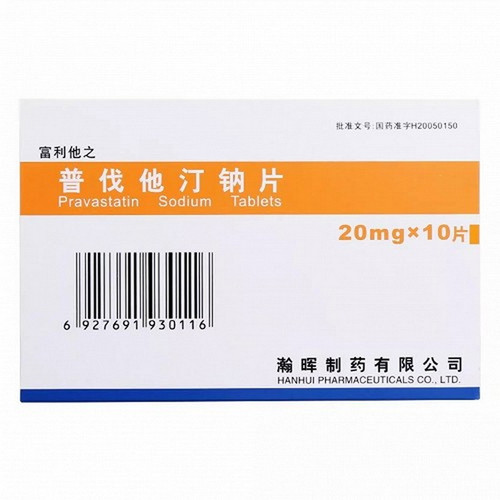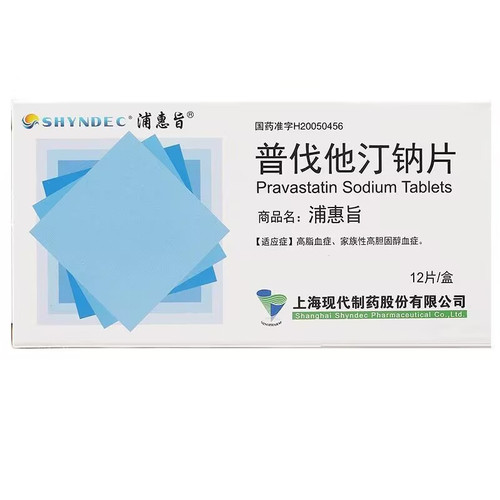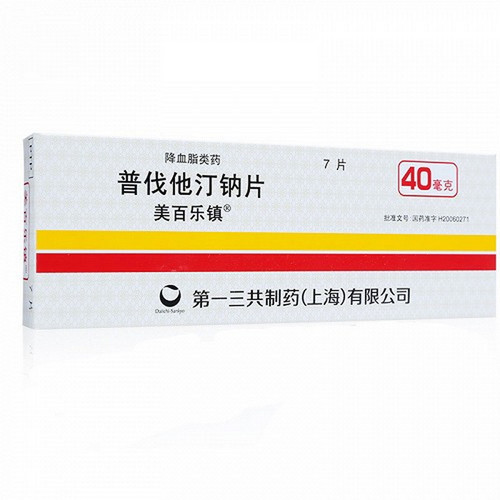Product Overview
[Drug Name]
Generic Name: Pravastatin Sodium Tablets
Trade Name: Fulitazhi Pravastatin Sodium Tablets 10mg x 10 Tablets
[Main Ingredient]
Pravastatin sodium.
[Properties]
This product is a light red tablet.
[Indications/Main Functions]
It is indicated for patients with primary hypercholesterolemia or concomitant hypertriglyceridemia (types IIa and IIb) that cannot be controlled with dietary restrictions.
[Precautions]
1. Like other HMG-CoA reductase inhibitors, this product may increase alkaline phosphatase and transaminase levels. Liver function tests are recommended before treatment, before dose adjustments, or as needed. This product is contraindicated in patients with active liver disease or unexplained persistent transaminase elevations. Use with caution in patients with a recent history of liver disease, those with signs of liver disease (e.g., unexplained persistent transaminase elevations, jaundice), or those who are alcoholics. For these patients, it is advisable to start with the minimum recommended dose and gradually adjust to the effective therapeutic dose, while closely observing. During treatment, if patients experience elevated transaminases or symptoms or signs of liver disease, liver function tests should be repeated until liver function returns to normal. If AST or ALT levels persistently exceed three times or more of the upper limit of normal, discontinue this drug. 2. This drug can rarely cause rhabdomyolysis with acute renal failure secondary to myoglobinuria, which can cause uncomplicated myalgia. Myopathy manifests as muscle tenderness or weakness near joints, accompanied by elevations in creatine phosphokinase (CPK) levels exceeding 10 times the upper limit of normal. Myopathy should be considered in patients with diffuse myalgia, tenderness, or weakness, and/or significantly elevated CPK. Report muscle pain, tenderness, or weakness immediately, especially if accompanied by fatigue or fever. If CPK levels are significantly elevated, myopathy is suspected or confirmed, and discontinue this drug. Discontinue use of this drug if the patient experiences acute or severe conditions that could lead to acute renal failure secondary to rhabdomyolysis, such as sepsis, hypotension, major surgery, trauma; severe metabolic or endocrine disorders, electrolyte imbalances; or uncontrolled epilepsy. When this drug is used in combination with clofibrates, clinical renal function abnormalities may occur. Therefore, it should be used only when clinically necessary. 3. Use with caution in the following patients: (1) Patients with severe liver damage or a history of such damage. (2) Patients with severe renal damage or a history of such damage. (3) Patients currently taking fibrates (such as bezafibrate), immunosuppressants (such as cyclosporine), or niacin.
[Drug Interactions]
Patients with a history of hypersensitivity to this drug or any of its ingredients.
[Pediatric Use]
The safety of this drug in pediatric use has not been established.
[Elderly Use]
The possibility of decreased renal function due to advanced age should be considered in elderly patients. Regular renal function tests should be performed, symptoms should be monitored, and medication should be administered with caution.
[Use during Pregnancy and Lactation]
1. The safety of this medication during pregnancy has not been established. Therefore, pregnant women or women who may become pregnant should only use this medication when the benefits outweigh the risks. 2. Lactating women should avoid this medication. If this medication is unavoidable, breastfeeding should be discontinued.
[Specifications]
10mg*10 tablets
[Dosage and Administration]
The starting dose for adults is 10-20 mg once daily, taken at bedtime. The dosage should be increased or decreased based on age and symptoms, with a maximum daily dose of 40 mg.
[Adverse Reactions]
1. Rhabdomyolysis: Rhabdomyolysis is characterized by muscle pain, fatigue, elevated CPK, and elevated blood and urine myoglobin levels. This can lead to severe renal damage, including acute renal failure. If these symptoms occur, the drug should be discontinued immediately. 2. Hepatic Dysfunction: Liver dysfunction, accompanied by jaundice and significant elevations in AST and ALT, may occur. Therefore, patients should be carefully observed. In such cases, the drug should be discontinued immediately and appropriate treatment should be administered. 3. Thrombocytopenia: Thrombocytopenia may occur, so careful observation and appropriate treatment should be implemented. (Thrombocytopenia accompanied by purpura and subcutaneous hemorrhage has been reported.) 4. Myopathy: Myopathy has been reported. 5. Peripheral neuropathy: Peripheral neuropathy has been reported. 6. Allergic symptoms: Allergic symptoms such as lupus-like syndrome and vasculitis have been reported.
[Contraindications]
Patients with a history of hypersensitivity to this product or any of its ingredients.
[Overdose]
To date, no overt clinical symptoms or clinical laboratory abnormalities have been reported in reports of pravastatin overdose. If an overdose occurs, systemic treatment should be initiated, and supportive monitoring measures should be established as required.
[Pharmacology and Toxicology]
1. Pharmacological Action: This product is a 3-hydroxy-3-methylglutaryl coenzyme A (HMG-CoA) reductase inhibitor. It selectively acts on the liver and small intestine, the primary organs for cholesterol synthesis, rapidly and strongly lowering serum cholesterol levels and improving serum lipids. This product exerts its lipid-lowering effects through two pathways. First, it reversibly inhibits HMG-CoA reductase activity, reducing the amount of intracellular cholesterol to a certain extent. This leads to an increase in the number of low-density lipoprotein (LDL) receptors on the cell surface, thereby enhancing receptor-mediated catabolism of low-density lipoprotein cholesterol (LDL-C) and its clearance from the blood. Second, it inhibits the production of LDL-C by inhibiting the synthesis of its precursor, very-low-density lipoprotein cholesterol (VLDL-C), in the liver. Studies have shown that elevated total cholesterol (TC), LDL-C, and apolipoprotein B (Apo B) can contribute to the development of atherosclerosis. Furthermore, lowering the levels of high-density lipoprotein cholesterol (HDL-C) and its transport complex, apolipoprotein A (Apo A), is also associated with atherosclerosis. Cardiovascular morbidity and mortality increase with increasing total cholesterol levels and decrease with increasing HDL levels. Although elevated triglyceride levels are often associated with low HDL levels, they cannot be considered an independent risk factor for coronary artery disease. The effects of simply increasing HDL or lowering triglycerides on the morbidity and mortality of coronary artery disease and cardiovascular disease are currently inconclusive. In healthy volunteers and patients with hypercholesterolemia, treatment with this drug has been shown to reduce TC, LDL, and Apo B, lower VLDL and triglycerides, and increase HDL and Apo A. The effects on other independent risk factors for coronary artery disease, such as Lp(a) and fibrinogen, are unclear. Clinical studies have shown that this drug can reduce the morbidity and mortality of cardiovascular disease in patients with varying degrees of elevated cholesterol. 2. Toxicological Effects: In a study of SD rats administered pravastatin sodium (10, 30, or 100 mg/kg/day mixed with food for 24 months), liver tumors were more pronounced in males compared to the control group in the 100 mg/kg/day group (250 times the maximum clinical dose), but not in females. In a study in dogs administered pravastatin sodium (12.5, 50, and 200 mg/kg/day, oral, for 5 weeks and 12.5, 50, and 200 mg/kg/day, oral, for 13 weeks), cerebral microvascular exudative hemorrhage and other symptoms were observed in the 100 mg/kg/day group.
[Pharmacokinetics]
1. Absorption, Distribution, and Metabolism: This drug is a water-soluble HMG-CoA reductase inhibitor, primarily absorbed from the duodenum. Following oral administration, it is rapidly absorbed and distributed in high concentrations in organs such as the liver and small intestine, where cholesterol biosynthesis is active. Distribution is minimal in organs such as the brain, adrenal glands, and reproductive organs. Maximum plasma concentrations are reached 1-2 hours after administration and increase in a dose-dependent manner. The half-life is approximately 1.5 hours, the volume of distribution is 830.0 L, the serum protein binding is 53.1%, and the AUC is 14.0 ± 3.9 ng × hr/mL. This product is primarily metabolized by the liver, but not by cytochrome P450 3A4. Steady-state AUCs, Cmax, and Cmin analyses indicate that this product (pravastatin) does not accumulate in the body, regardless of whether it is taken once or twice daily. 2. Excretion: This product is eliminated through both the liver and kidneys: primarily through fecal excretion (over 80%), with urinary excretion accounting for 2% to 13%. Therefore, patients with renal or hepatic impairment may achieve clearance through compensatory changes in excretion pathways.







